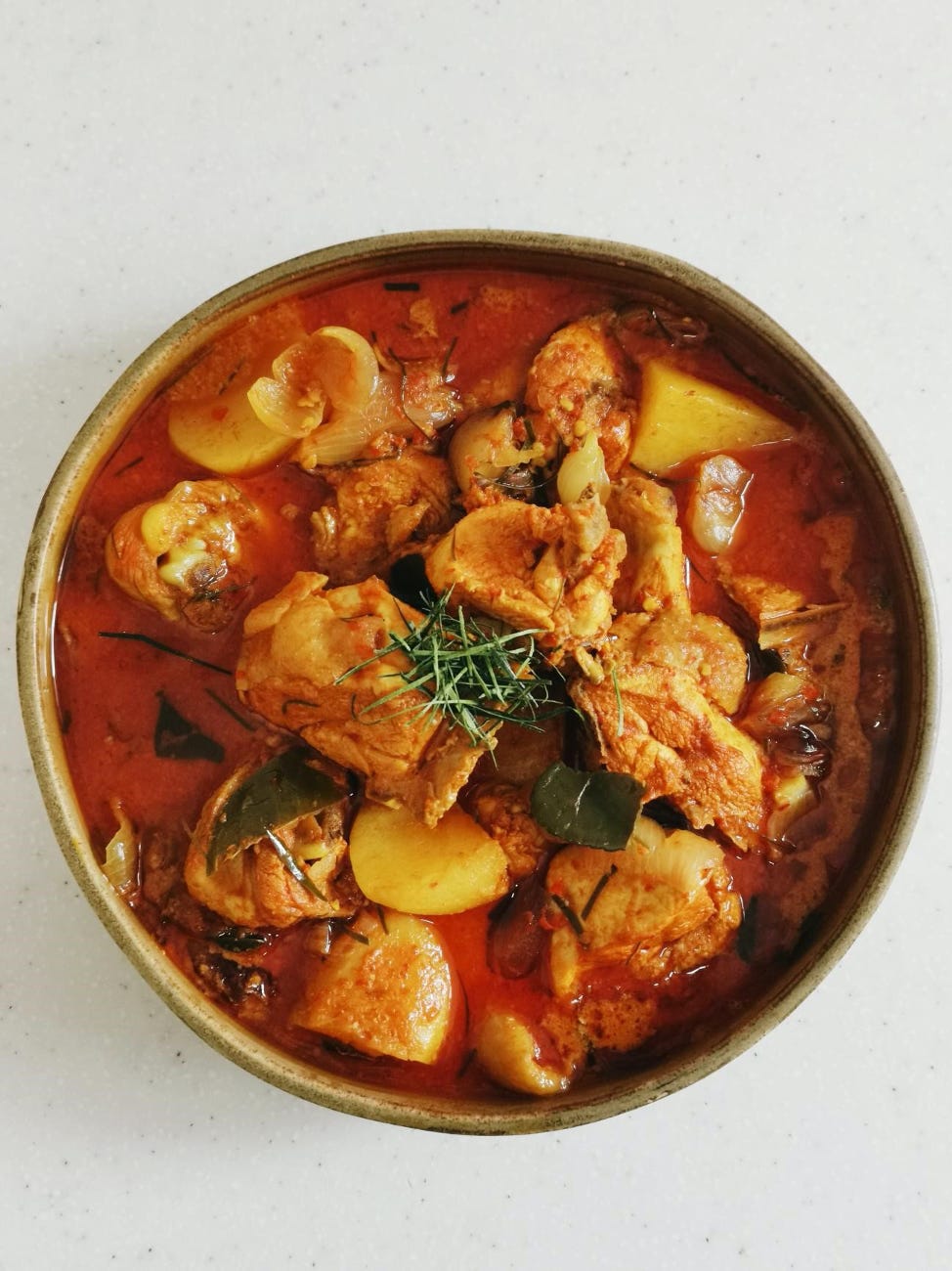“When I think of Kari Kapitan, my Popo (maternal grandmother) comes to mind. I have fond memories of her in the kitchen everyday, preparing lunch and dinner like a full-time chef in a restaurant. I’ve always enjoyed all her dishes, but her Tau You Bak, Achar Hu and Kari Kapitan were my favourites. I always lingered around the kitchen and loved to hear the sound of her pestle and mortar “ringing” – tok… tok… tok… The fragrance of the spices were always the best when pounded fresh.
My Popo has always been strict about who gets to learn her recipes, and it was tough trying to persuade her to teach me. She finally agreed to teach me only 2 years ago! Kari Kapitan was a dish she learnt from her mother-in-law, my Chorchor (Great-grandmother), and it was always the best dish on the dining table. My grandfather and I would flood our plates with the gravy and rice, even dipping bread into the gravy to mop up every last bit.
Like in every Asian household, my Popo’s cooking was all about “agak-agak”. I was comfortable cooking dishes the Western way, with exact measurements, but I wasn’t familiar with Asian cooking, let alone Nyonya cooking! To document every step of the dish, I was ready in the kitchen with my pen, paper and my phone fully charged. I had to be quick and observant, because sometimes she may forget to explain some steps, being so absorbed in the cooking process My grandmother constantly tasted her Kari Kapitan as it cooked. I followed suit, noting how rich and flavorful the dish is at each stage.
During the COVID-19 lockdown in KL, I decided to finally try remaking her recipe from the notes and photos from 2 years before. My grandmother now has Alzheimer’s disease and can’t remember how to cook, so I couldn’t really ask her for help. However, cooking this dish was delightful because she could slowly recall the steps as I was cooking and that really made me happy. I took it as a challenge to nail this dish to taste as similar as possible to my Chorchor’s, and turned to my grandfather to ask if the dish was similar to his mother’s.
This dish became an everyday dish for about 2 weeks because I kept attempting to nail this dish while my grandfather kept me company and recounting what he remembers of the dish while sitting at the corner of the kitchen. The Kari Kapitan has to be: sour, spicy, savoury, “lemak” or creamy, and sweet; and this recipe ticks all the right boxes.
Kari Kapitan is best consumed after 4 hours, better if left overnight in the fridge and eaten the next day.” - Sean Koay
Sean Koay’s Kari Kapitan
Serves 6-10
140g shallots
Cooking oil
23g dried chillies
70g red chillies
17g bird’s eye chillies (chilli padi)
25g garlic
1.5kg chicken, cut into pieces
1-2 teaspoons turmeric powder
10 kaffir lime leaves (cut 5 of the leaves into thin strips and leave the rest whole)
4 potatoes, quartered
250g coconut milk
3-4 teaspoons salt
4-5 tablespoons sugar
25g lime juice
In a pestle and mortar, lightly crush the shallots to break them open. Saute them in a good amount of cooking oil over medium heat. Cook until they turn slightly translucent and are fragrant. Set aside, we will use both the shallots and shallot oil later.
To prepare a rempah, halve the dried chillies with a pair of scissors and soak in hot water – this softens them quickly and causes some of the seeds to come out of the chillies – you can discard the seeds if you prefer a less spicy Kari Kapitan.
Blend the softened dried chillies with the red chillies, birds’ eye chillies and garlic until a fine paste is formed, adding some water from soaking the dried chillies if necessary. Do not use too much water as it may cause spitting when you saute the rempah.
With the shallot oil in a pot or large saucepan on medium heat, add your rempah to the oil and saute until slightly darkened, fragrant and thickened.
Adjust the heat to medium low, add the chicken and coat it with the spice paste.
Allow it to sit in the heat for about 3 minutes before adding the kaffir lime leaves and turmeric powder. Stir the chicken – you want to prevent it from burning at the bottom of the pot and allow the heat to draw the oils out of the kaffir lime leaves. In my family, we keep some kaffir lime leaves whole while slicing the rest thinly as we believe the flavour comes out the most from the leaves if they are cut into thin strips.
Rinse the blender with some water and add enough to cover the chicken, and bring to a boil. You can add more or less water, depending on how watery or thick you’d like the gravy to be.
Add the quartered potatoes, coconut milk, salt, sugar and simmer for about 10 minutes or until the chicken and potatoes are fully cooked.
Add the lime juice and sauteed shallots. Mix well and taste.
Kari Kapitan is usually best served 4-5 hours after cooking. Transfer the Kari Kapitan to a serving dish.




